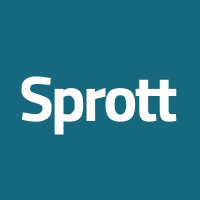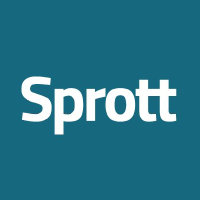
Sprott Inc
TSX:SII


| US |

|
Johnson & Johnson
NYSE:JNJ
|
Pharmaceuticals
|
| US |

|
Berkshire Hathaway Inc
NYSE:BRK.A
|
Financial Services
|
| US |

|
Bank of America Corp
NYSE:BAC
|
Banking
|
| US |

|
Mastercard Inc
NYSE:MA
|
Technology
|
| US |

|
UnitedHealth Group Inc
NYSE:UNH
|
Health Care
|
| US |

|
Exxon Mobil Corp
NYSE:XOM
|
Energy
|
| US |

|
Pfizer Inc
NYSE:PFE
|
Pharmaceuticals
|
| US |

|
Palantir Technologies Inc
NYSE:PLTR
|
Technology
|
| US |

|
Nike Inc
NYSE:NKE
|
Textiles, Apparel & Luxury Goods
|
| US |

|
Visa Inc
NYSE:V
|
Technology
|
| CN |

|
Alibaba Group Holding Ltd
NYSE:BABA
|
Retail
|
| US |

|
3M Co
NYSE:MMM
|
Industrial Conglomerates
|
| US |

|
JPMorgan Chase & Co
NYSE:JPM
|
Banking
|
| US |

|
Coca-Cola Co
NYSE:KO
|
Beverages
|
| US |

|
Walmart Inc
NYSE:WMT
|
Retail
|
| US |

|
Verizon Communications Inc
NYSE:VZ
|
Telecommunication
|
Utilize notes to systematically review your investment decisions. By reflecting on past outcomes, you can discern effective strategies and identify those that underperformed. This continuous feedback loop enables you to adapt and refine your approach, optimizing for future success.
Each note serves as a learning point, offering insights into your decision-making processes. Over time, you'll accumulate a personalized database of knowledge, enhancing your ability to make informed decisions quickly and effectively.
With a comprehensive record of your investment history at your fingertips, you can compare current opportunities against past experiences. This not only bolsters your confidence but also ensures that each decision is grounded in a well-documented rationale.
Do you really want to delete this note?
This action cannot be undone.

| 52 Week Range |
42.73
65.7
|
| Price Target |
|
We'll email you a reminder when the closing price reaches CAD.
Choose the stock you wish to monitor with a price alert.

|
Johnson & Johnson
NYSE:JNJ
|
US |

|
Berkshire Hathaway Inc
NYSE:BRK.A
|
US |

|
Bank of America Corp
NYSE:BAC
|
US |

|
Mastercard Inc
NYSE:MA
|
US |

|
UnitedHealth Group Inc
NYSE:UNH
|
US |

|
Exxon Mobil Corp
NYSE:XOM
|
US |

|
Pfizer Inc
NYSE:PFE
|
US |

|
Palantir Technologies Inc
NYSE:PLTR
|
US |

|
Nike Inc
NYSE:NKE
|
US |

|
Visa Inc
NYSE:V
|
US |

|
Alibaba Group Holding Ltd
NYSE:BABA
|
CN |

|
3M Co
NYSE:MMM
|
US |

|
JPMorgan Chase & Co
NYSE:JPM
|
US |

|
Coca-Cola Co
NYSE:KO
|
US |

|
Walmart Inc
NYSE:WMT
|
US |

|
Verizon Communications Inc
NYSE:VZ
|
US |
This alert will be permanently deleted.
 Sprott Inc
Sprott Inc
Sprott Inc
Sprott Inc., founded in Canada, is a distinctive entity in the financial world, with a clear-cut focus on the precious metals and real assets sector. The firm has carved out a niche by providing bespoke investment strategies that cater to this specific market segment, offering a range of services including asset management, wealth management, and brokerage solutions. By harnessing its deep expertise in precious metals, Sprott has positioned itself as a trusted partner for investors seeking exposure to gold, silver, and other related commodities. This focus has allowed the company to tap into the unyielding allure and historical significance of these assets, which are often seen as safe havens during turbulent financial times.
The company generates revenue through various channels, the primary being fees from its asset management services. These services involve managing mutual funds, exchange-traded funds (ETFs), and private funds that invest in the precious metals and real assets domain. Additionally, Sprott derives income through commissions and fees from its brokerage operations, offering tailored financial advice and services to high-net-worth individuals and institutional clients. Its robust business model is underpinned by the cyclical nature of commodities, allowing Sprott to leverage its specialized expertise, thereby creating value for its clients. By aligning its interests with a particularly resilient asset class, Sprott not only fortifies its own financial foundation but also enhances its appeal as a guardian of wealth for investors seeking stability and potential growth.

Sprott Inc., founded in Canada, is a distinctive entity in the financial world, with a clear-cut focus on the precious metals and real assets sector. The firm has carved out a niche by providing bespoke investment strategies that cater to this specific market segment, offering a range of services including asset management, wealth management, and brokerage solutions. By harnessing its deep expertise in precious metals, Sprott has positioned itself as a trusted partner for investors seeking exposure to gold, silver, and other related commodities. This focus has allowed the company to tap into the unyielding allure and historical significance of these assets, which are often seen as safe havens during turbulent financial times.
The company generates revenue through various channels, the primary being fees from its asset management services. These services involve managing mutual funds, exchange-traded funds (ETFs), and private funds that invest in the precious metals and real assets domain. Additionally, Sprott derives income through commissions and fees from its brokerage operations, offering tailored financial advice and services to high-net-worth individuals and institutional clients. Its robust business model is underpinned by the cyclical nature of commodities, allowing Sprott to leverage its specialized expertise, thereby creating value for its clients. By aligning its interests with a particularly resilient asset class, Sprott not only fortifies its own financial foundation but also enhances its appeal as a guardian of wealth for investors seeking stability and potential growth.





























 You don't have any saved screeners yet
You don't have any saved screeners yet
